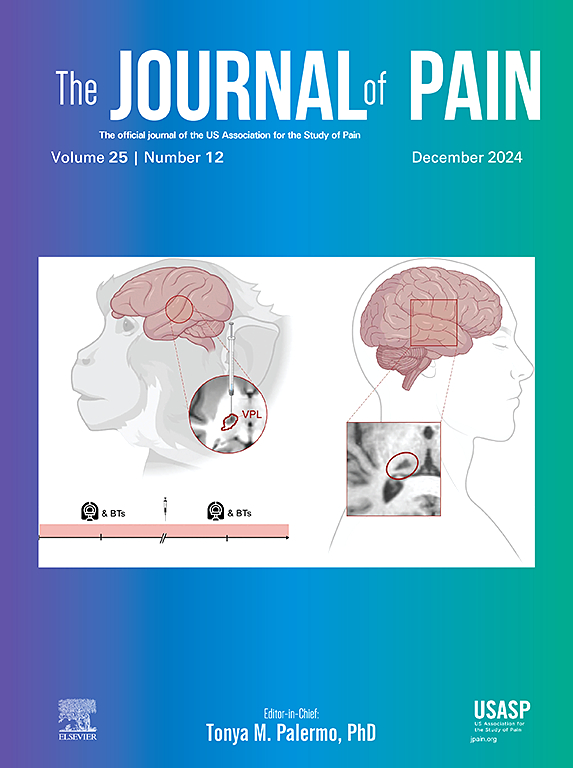体育锻炼可预测健康人的条件性疼痛调节:一项横断面研究。
IF 4
2区 医学
Q1 CLINICAL NEUROLOGY
引用次数: 0
摘要
即使在健康人群中,条件性疼痛调节(CPM)的幅度也各不相同。这可能是包括体育锻炼在内的(非)可调节因素造成的。然而,很少有研究对代表性样本中的体力活动及其与 CPM 幅值的关系进行深入研究。因此,本研究调查了 105 名健康成年人的体力活动对 CPM 幅值的预测作用。通过使用国际体力活动调查问卷进行自我报告,并使用基于监测的加速度计对连续七天的体力活动进行评估。采用异位有害调节刺激方案对 CPM 进行了检查,在该方案中,评估了热水调节刺激对压力痛阈的影响。研究人员进行了比较、相关和分层线性回归分析。基于报告的步行预测了疼痛调节能力差异的 4.8%,适度体力活动预测了疼痛调节能力差异的 10.2%,基于报告的总体力活动时间预测了疼痛调节能力差异的 7.0%。总体力活动(包括步行和适度体力活动)花费的 MET 分钟/周越多,疼痛调节能力就越大。这项研究的结果为体力活动对 CPM 的预测作用提供了更多有限的证据。它敦促人们在研究 CPM 时将体力活动视为一个混杂因素。本研究提供的证据表明,积极的体育锻炼生活方式有利于健康成年人的内源性疼痛调节。鉴于其潜力,对于已知 CPM 受损的疼痛患者来说,步行和中等强度的体育锻炼可能是可行的治疗策略。观点:本文的研究结果表明,积极的生活方式,包括更多的步行和中等强度的活动,预示着更强的疼痛调节能力。试验登记:本研究尚未进行预先登记。本文章由计算机程序翻译,如有差异,请以英文原文为准。
Physical Activity Is Predictive of Conditioned Pain Modulation in Healthy Individuals: A Cross-Sectional Study
Even in healthy populations, conditioned pain modulation (CPM) magnitude varies. This may be accounted for by (non-)modifiable factors, including physical activity (PA). Yet, little research has thoroughly examined PA and its relation with CPM magnitude in a representative sample. Therefore, the present study investigated the predictive effect of PA on CPM magnitude in 105 healthy adults. PA was assessed during 7 consecutive days by self-report using the International Physical Activity Questionnaire and by monitor-based accelerometry. CPM was examined using a heterotopic noxious-conditioning stimulation protocol during which the effect of a hot water-conditioning stimulus on pressure pain thresholds was evaluated. Comparative, correlation, and hierarchical linear regression analyses were performed. Report-based walking predicts 4.8% of variance in pain-modulatory capacity, moderate PA predicts 10.2% of variance in pain-modulatory capacity, and report-based time spent on total PA predicts 7.0% of variance in pain-modulatory capacity. More metabolic equivalent-minutes/week spent on total PA, including walking and moderate PA, is associated with greater pain-modulatory capacity. The findings of this study add to the limited evidence on the predictive effect of PA on CPM. It urges to consider PA a confounding factor when examining CPM. The current study provides evidence that a physically active lifestyle benefits endogenous pain modulation in healthy adults. Given its potential, walking and moderate-intensity PA might be achievable treatment strategies for pain patients known to have impaired CPM.
Perspective
The results of this article show that a physically active lifestyle, including larger amounts of walking and moderate activity, predicts greater pain-modulatory capacity.
Trial Registration
This study has not been preregistered.
求助全文
通过发布文献求助,成功后即可免费获取论文全文。
去求助
来源期刊

Journal of Pain
医学-临床神经学
CiteScore
6.30
自引率
7.50%
发文量
441
审稿时长
42 days
期刊介绍:
The Journal of Pain publishes original articles related to all aspects of pain, including clinical and basic research, patient care, education, and health policy. Articles selected for publication in the Journal are most commonly reports of original clinical research or reports of original basic research. In addition, invited critical reviews, including meta analyses of drugs for pain management, invited commentaries on reviews, and exceptional case studies are published in the Journal. The mission of the Journal is to improve the care of patients in pain by providing a forum for clinical researchers, basic scientists, clinicians, and other health professionals to publish original research.
 求助内容:
求助内容: 应助结果提醒方式:
应助结果提醒方式:


